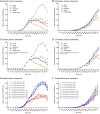Contrasting Epidemiology and Clinicopathology of Female Breast Cancer in Asians vs the US Population
- PMID: 31093668
- PMCID: PMC6910158
- DOI: 10.1093/jnci/djz090
Contrasting Epidemiology and Clinicopathology of Female Breast Cancer in Asians vs the US Population
Abstract
Background: The incidence of breast cancer among younger East Asian women has been increasing rapidly over recent decades. This international collaborative study systemically compared the differences in age-specific incidences and pathological characteristics of breast cancer in East Asian women and women of predominantly European ancestry.
Methods: We excerpted analytic data from six national cancer registries (979 675 cases) and eight hospitals (18 008 cases) in East Asian countries and/or regions and, for comparisons, from the US Surveillance, Epidemiology, and End Results program database. Linear regression analyses of age-specific incidences of female breast cancer and logistic regression analyses of age-specific pathological characteristics of breast cancer were performed. All statistical tests were two-sided.
Results: Unlike female colorectal cancer, the age-specific incidences of breast cancer among East Asian women aged 59 years and younger increased disproportionally over recent decades relative to rates in US contemporaries. For years 2010-2014, the estimated age-specific probability of estrogen receptor positivity increased with age in American patients, whereas that of triple-negative breast cancer (TNBC) declined with age. No similar trends were evident in East Asian patients; their probability of estrogen receptor positivity at age 40-49 years was statistically significantly higher (odd ratio [OR] = 1.50, 95% confidence interval [CI] = 1.36 to 1.67, P < .001) and of TNBC was statistically significantly lower (OR = 0.79, 95% CI = 0.71 to 0.88, P < .001), whereas the probability of ER positivity at age 50-59 years was statistically significantly lower (OR = 0.88, 95% CI = 0.828 to 0.95, P < .001). Subgroup analyses of US Surveillance, Epidemiology, and End Results data showed similarly distinct patterns between East Asian American and white American patients.
Conclusions: Contrasting age-specific incidences and pathological characteristics of breast cancer between East Asian and American women, as well as between East Asian Americans and white Americans, suggests racial differences in the biology.
© The Author(s) 2019. Published by Oxford University Press. All rights reserved. For permissions, please email: journals.permissions@oup.com.
Figures




Comment in
-
Is Breast Cancer in Asian and Asian American Women a Different Disease?J Natl Cancer Inst. 2019 Dec 1;111(12):1243-1244. doi: 10.1093/jnci/djz091. J Natl Cancer Inst. 2019. PMID: 31093671 Free PMC article. No abstract available.
-
Response to Sung, Rosenberg, and Yang.J Natl Cancer Inst. 2020 May 1;112(5):547-548. doi: 10.1093/jnci/djz191. J Natl Cancer Inst. 2020. PMID: 31545369 Free PMC article. No abstract available.
-
Re: Contrasting Epidemiology and Clinicopathology of Female Breast Cancer in Asians vs the US Population.J Natl Cancer Inst. 2020 May 1;112(5):545-546. doi: 10.1093/jnci/djz190. J Natl Cancer Inst. 2020. PMID: 31545370 Free PMC article. No abstract available.
References
-
- Shin HR, Joubert C, Boniol M, et al. Recent trends and patterns in breast cancer incidence among Eastern and Southeastern Asian women. Cancer Causes Control. 2010;21(11):1777–1785. - PubMed
-
- Minami Y, Tsubono Y, Nishino Y, Ohuchi N, Shibuya D, Hisamichi S.. The increase of female breast cancer incidence in Japan: emergence of birth cohort effect. Int J Cancer. 2004;108(6):901–906. - PubMed
-
- Shen YC, Chang CJ, Hsu C, Cheng CC, Chiu CF, Cheng AL.. Significant difference in the trends of female breast cancer incidence between Taiwanese and Caucasian Americans: implications from age-period-cohort analysis. Cancer Epidemiol Biomarkers Prev. 2005;14(8):1986–1990. - PubMed
Publication types
MeSH terms
Substances
LinkOut - more resources
Full Text Sources
Medical
Research Materials
Miscellaneous

